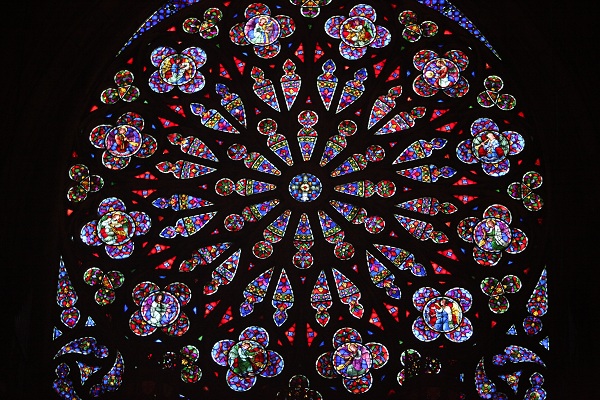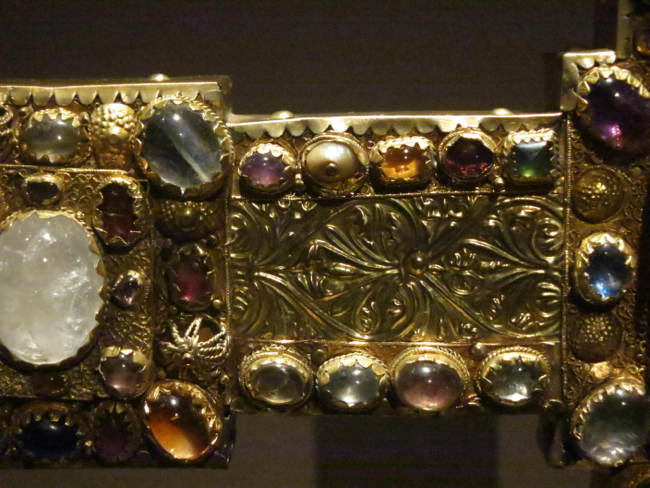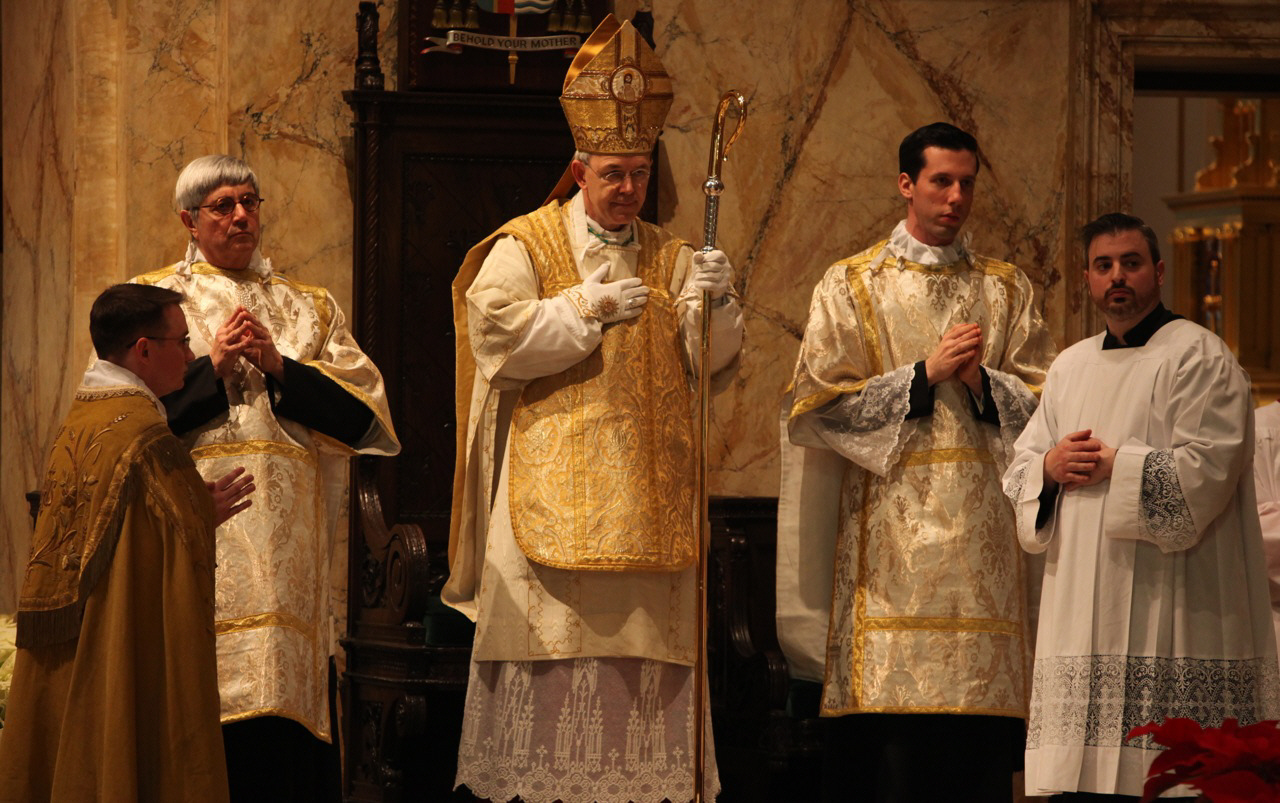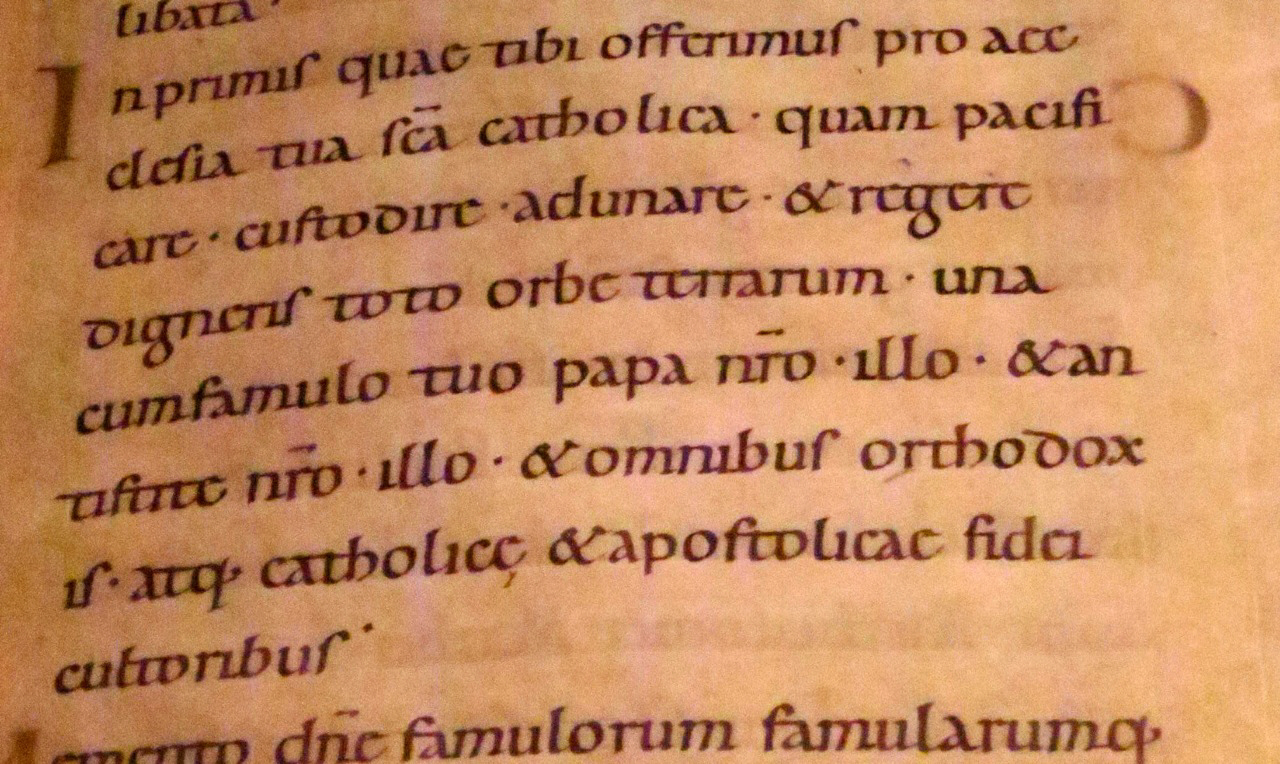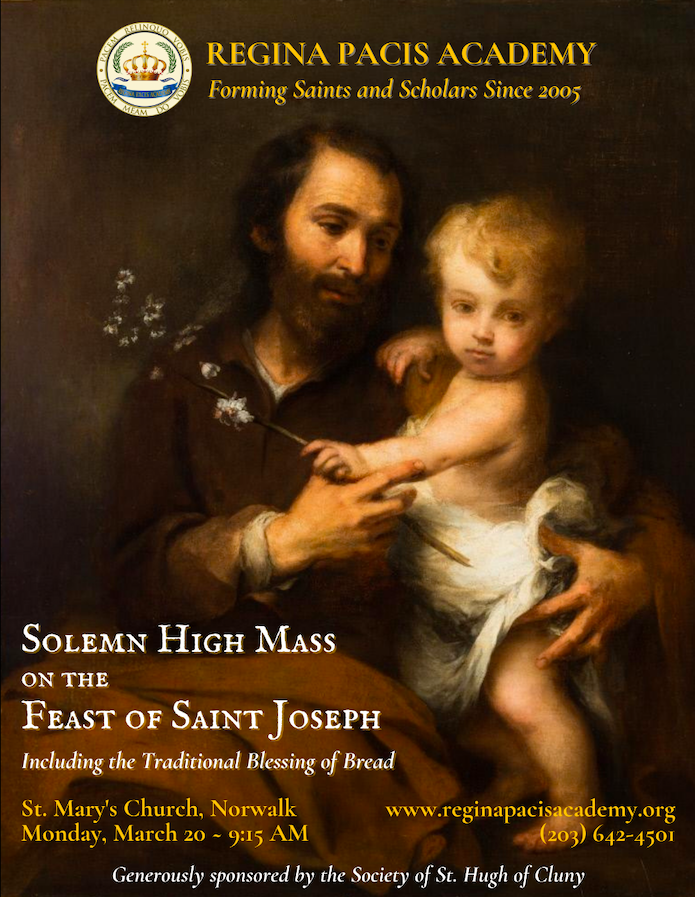

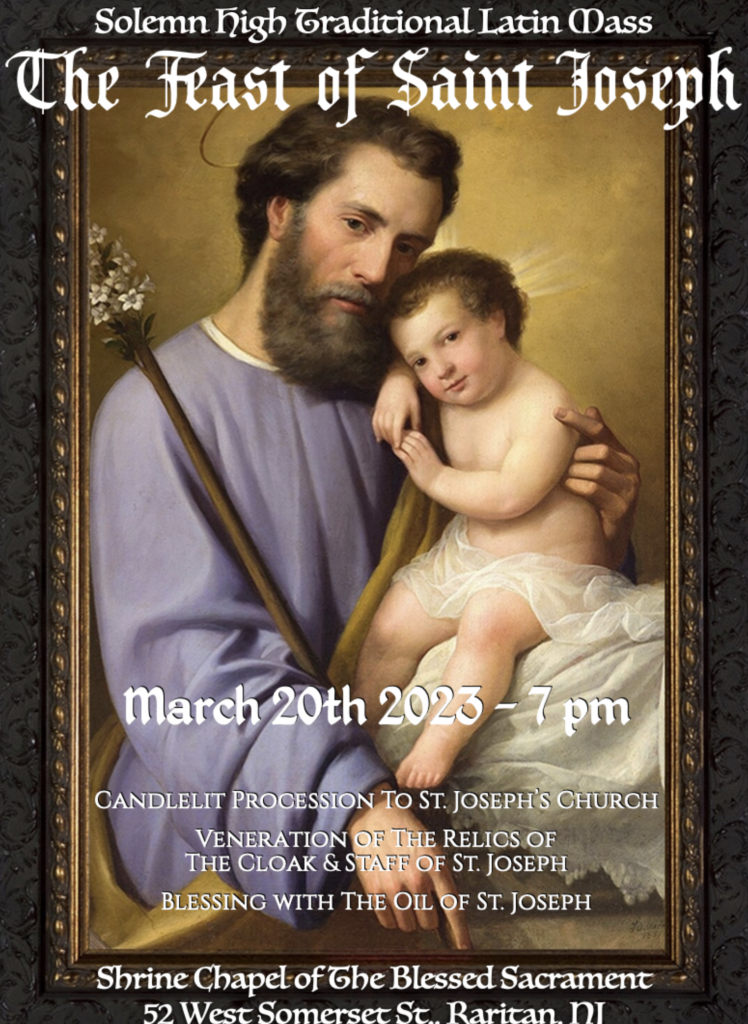
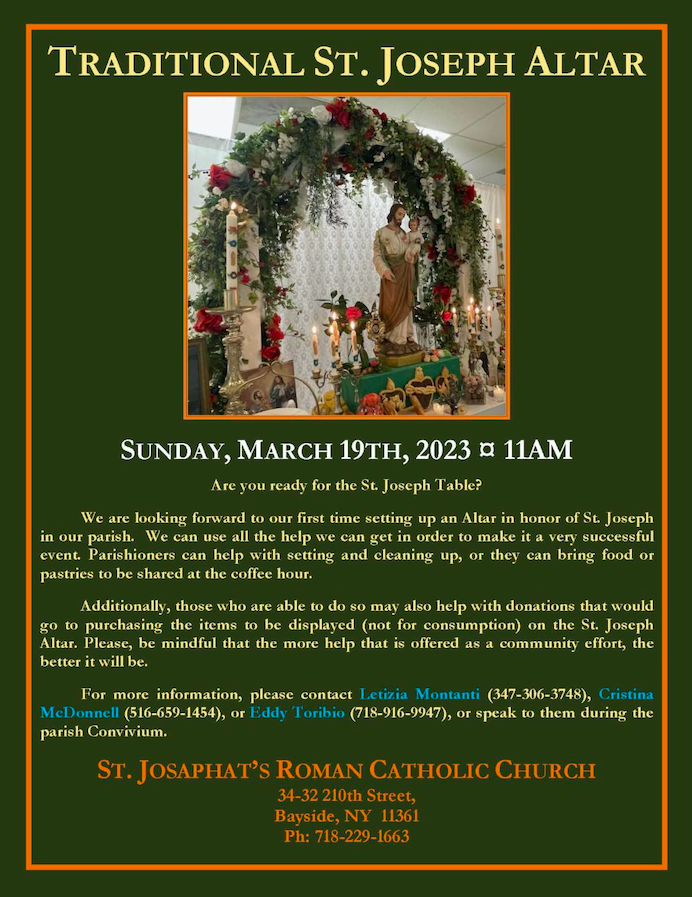
13
Mar
12
Mar
A total of 117 woman attended a retreat over the weekend directed by Fr. John Perricone in the beautiful Seminary of the Immaculate Conception Retreat House in Huntington, Long Island. Fr. Perricone celebrated the traditional Mass.
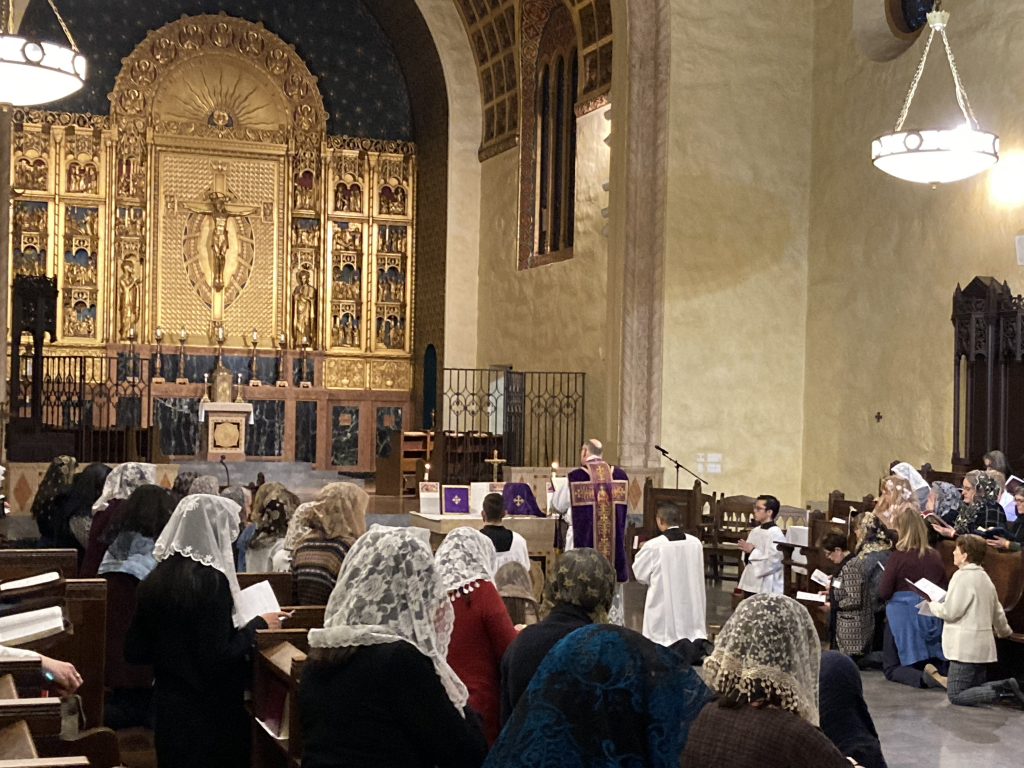
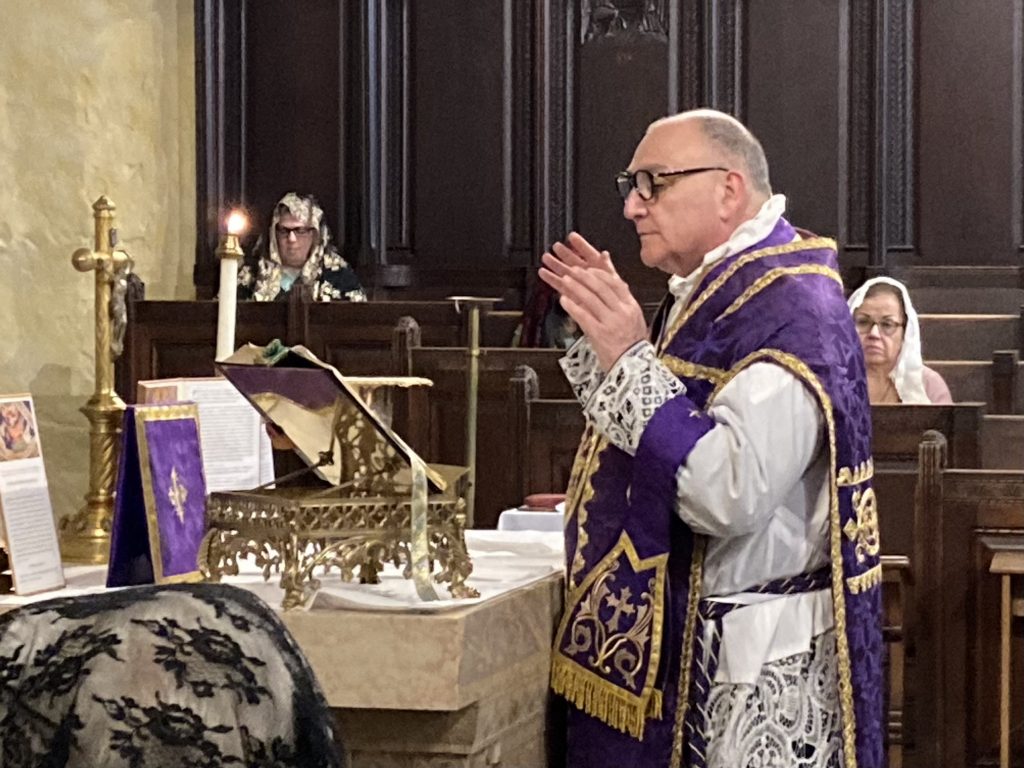
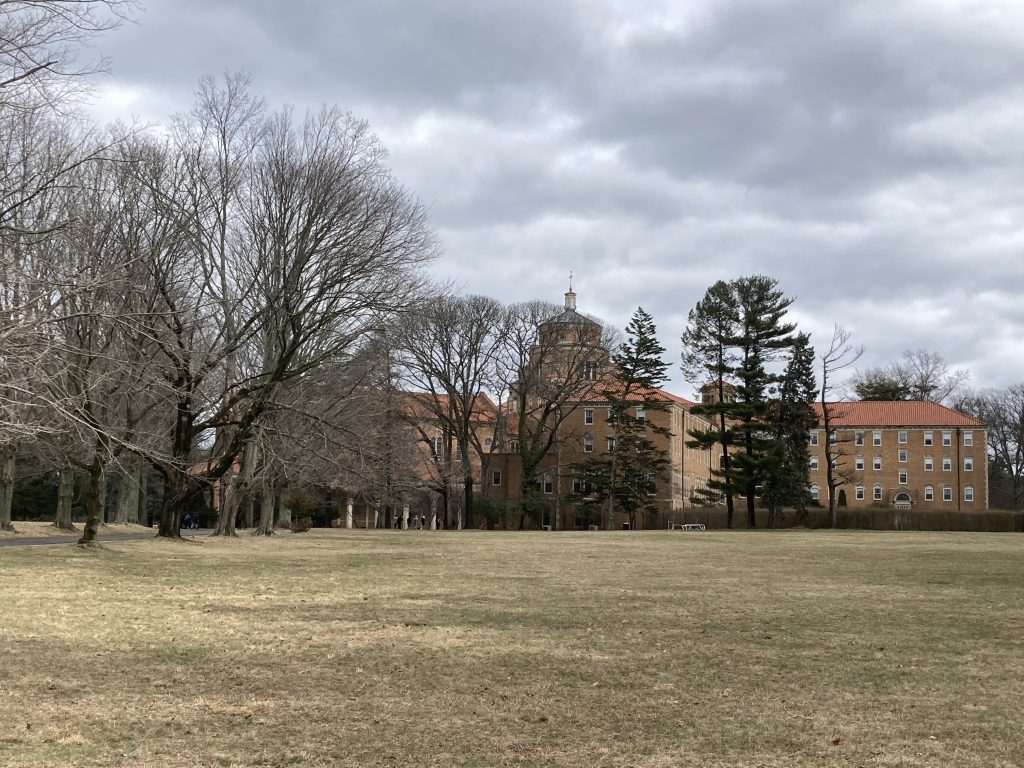

7
Mar
I have not been directly commenting on the developments that have been afflicting traditionalists. Partly, because I can draw on no privileged sources of information. Partly, because I could add little to the many eloquent testimonials and analyses readily available to all. Finally, because of the sheer volume of materials emerging as the war against both the Traditional Mass and the Catholic faith engulfs the whole Church. For example, I have not yet been able to read any of the books that saw the light of day at the end of last year: by Gänswein, by the late Pope Benedict, etc. But let me now summarize briefly the current situation – all of which should be familiar to our readers – and add some personal comments.
Indisputably, the Church is entering a dramatic and tragic time. In Germany, and not just there, the synodal path is reaching a decisive phase. A major church like Germany may imminently adopt doctrines and a constitution incompatible with the basic tenets of Catholicism. A schism will arise – that is, unless Pope Francis expressly or silently endorses the German decisions. But that will create an even greater crisis! Already, outside of Germany, bishops are publicly accusing other bishops of teaching heresy. (In fact, of course, they have been teaching it for a long time! ). Throughout the Church, the prevalence doctrinal confusion regarding the most fundamental principles of Christian morality is devastating and disheartening.
As for traditionalism, with the rescriptum of February 2023 Francis redoubled his commitment to his flagging war against Catholic tradition. Indeed, in some respects the impact of this document was greater than anything else issued since Traditionis Custodes itself. Although basically it is republishing and endorsing a document from 2021, the rescriptum demonstrates beyond the shadow of the doubt the “steely determination” (Christopher Lamb) of Francis to eliminate Catholic traditionalism. Rumors continue about further documents to be issued, this time perhaps targeting the Ecclesia Dei institutes. We have not yet seen anything authoritative in this regard. However, reputable observers have pointed out that the rumors seem very specific, and, in the case of Francis, one cannot exclude any action at any time. All of this is happening – or is rumored to shortly happen – in the so-called “Holy Season” of Lent and Eastertide.
Here in our own New York neighborhood, we see in some dioceses traditional mass after mass being terminated without explanation or even the courtesy of a notice. In some cases, the faithful are exiled to a school gymnasium or chapel. It is a perfect image of the hatred Francis and most of his bishops have for the traditionalist faithful. In other dioceses, however, quiet still prevails on the liturgical front.
The “optics” of these actions are terrible. Coming so soon after the death of Pope Benedict, the pope’s and the Church’s deeds confirm the self-understanding of the “conciliar” Church as totally breaking with the past – not just of the Church prior to the Council, but even of that which existed under John Paul II and Benedict as well. The suspicion of a personal vendetta also naturally arises. And all this is occurring amid a never-ending series of outrageous sexual and financial scandals at the Vatican and at the level of the national churches: France, Germany, the UK , Portugal…. Do I need to add that all the objective indicia of the life of the Church (the level of religious practice, vocations, financial resources, etc.) indicate disastrous decline? Yet the Pope and most bishops pursue their anti-Traditionalist war and “synod on synodality” completely indifferent to the storm clouds enveloping the Church. Is it any wonder that, even in the camp of the progressives, Massimo Faggioli speaks of “paralysis” and Cardinal Kaspar opines:
The Church is in a very profound crisis. It is indisputable that we can’t continue as before. But how the future of the Church will look in detail – none of us knows. 1)
Yet, on the local level the traditionalist priests and faithful carry on. They continue the basic apostolate of traditionalism: to celebrate the Latin mass and, if they can, the other sacraments. I do not see the slightest evidence of despair, conformism, or susceptibility to any possible reeducation programs. Yes, it is a bitter blow to leave churches that the traditionalists in some cases had refurbished at great cost; to experience contempt and rejection by bishops with whom they had made every effort to remain on good terms. It is especially tragic for the young priests who cannot celebrate the sacraments in the form they love.
Ten years ago, I asked: how would American traditionalists respond if the Church renewed the persecution of the 1960s and 1970s? So far, the answer has been clear: the faithful are continuing the practice of the traditional Catholic faith, are forging links with other traditionalists and even, where it is the only option available, taking measures to survive underground. I have no doubt that the Traditionalist movement will survive and even be strengthened by these trials. Was this not the experience of the Church in the 3rd century under the declining Roman Empire when the great persecutions of Decius and Diocletian took place?
In this situation when everything seems to be in flux, and conflict and confusion reign, the Catholic must not succumb to fear. Pope Francis and his minions rule by fear: the fear of the actions they may take, of the statements they may make, of the men they may appoint. The fear and confusion are compounded by the lack of transparency that, regrettably, still prevails in the Roman Catholic Church at all levels: in the Vatican, the dioceses, and the individual parishes. But nevertheless, we cannot yield to fear. I have been privileged to meet and hear the testimony of witnesses – such as the late Cardinal Pell – who have resolutely encountered similar or greater storms. Traditionalism – which, after all, is nothing but the simple practice of the Catholic Faith in its fullest – has survived many things. It will survive this onslaught.
At the Society of Saint Hugh of Cluny, we remain committed to the cause confirmed by Pope Benedict with Summorum Pontificum. You may have recently noticed that after the lengthy hiatus caused by the COVID measures the Society has finally reemerged, sponsoring masses and lectures. It may be that we will not be able to report on things as openly as we did in the past. It may be that our sponsorships will need to be made quietly. And I don’t want to make any guesses as to when and how this extraordinary crisis of the Church may end. Rest assured, however, that this apostolate will continue in the firm hope of a better day.
6
Mar
Please join us for a special lecture we are sponsoring next week.
Dr. John Lamont has been an active participant in the controversies and debates created by the pontificate of Francis. I am sure that his remarks will be frank, incisive, and stimulating. Dr. Lamont has been a welcome guest in the past of the Society of St. Hugh of Cluny. Space in the conference room will be very limited, so I suggest you plan to arrive early.
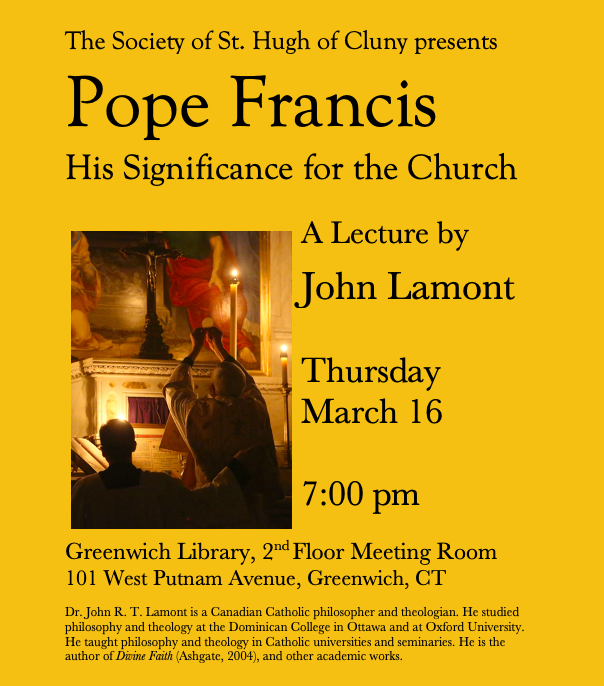
6
Mar
We have been informed: the Sunday Traditional Latin Mass at St. Emery Church in Fairfield, CT (7:45 am) has been cancelled. The last Mass will be on March 19.
5
Mar
Tuesday, March 7 is the traditional feast day of St. Thomas Aquinas, o.p. There will be a Solemn Mass in the Dominican Rite at 7 pm at St. Vincent Ferrer for which the Schola Cantorum will sing Missa Sancti Wilhelmi devotio by John Taverner.
5
Mar
Our Lady of Sorrows, Jersey City Traditional Holy Week 2023
Sunday, April 2 – Palm Sunday – 8:45am Blessing of Palms and Triumphal Procession, Passion of Our Lord according to Matthew. Berchem O Jesu Christe, Dubois Adoramus Te Christe.
Wednesday, April 5 – Tenebrae – 7:00pm Ancient Office of Darkness beginning the Triduum. The name “Tenebrae” has been given this Office because it is celebrated in the hours of darkness. Gregorian Chant, Polyphonic Motets of Victoria and others. Allegri’s Miserere.
Thursday, April 6 – Holy Thursday – 7:00pm Sung Mass of the Lord’s Supper and Procession to the altar of repose. Stripping of the Altar. Vigil before the Altar of Repose until Midnight (a plenary indulgence is granted to anyone who spends one hour in prayer before the Altar of Repose). Gregorian and Ambrosian Chant. Durufle’s Ubi Caritas,
Friday, April 7 – Good Friday – 3:00pm Mass of the Presanctified. On this day, the anniversary of our Savior’s death, the Church gives her temples an appearance of desolation and clothes her ministers in the garb of mourning. Chanting of the Passion of Our Lord According to John, Solemn Petitions, Unveiling and Veneration of the Cross, Holy Communion. Monteverdi’s Adoramus Te, etc. Immediately after the liturgy, procession through the streets with Our Lady of Sorrows giving witness to the world of our redemption.
Saturday, April 8 – Holy Saturday – 10:15pm The lengthy rites of the Easter Vigil are some of the most symbolic of the entire liturgical year penetrating to the very roots of salvation, especially through the many allusions to the sacrament of baptism—made possible by Our Lord’s resurrection. Lighting of the Easter Fire, the Lumen Christi Procession, the Exsultet, the Prophecies, the blessing of the Water and Baptismal Font, the Profession of Faith, the Easter Alleluia and the Eucharistic Sacrifice. Anerio-Palestrina Missa Papae Marcelli with chamber orchestra; Erbach Dum Transisset; Franck Dextera Domini.
All liturgies will be in Latin and will follow the traditional ordo and rubrics. The Traditional Latin Mass, which can never be abrogated (SF), is celebrated every Sunday at 9:00 am at Our Lady of Sorrows. Off-street parking is available in the lot across the street from the church.
Rev. John Perricone, Priest; Simone Ferraresi, Music Director, Cantantes In Cordibus; Art Manabat, Assistant Director of Cantantes In Cordbus; Dr. Joseph Orchard, PhD, Director of the Men’s Schola; Harry Melendez, Anthony Ambrogio, Michael Wisniewski, and Eric Szwerc, MCs
28
Feb
The Guild of the Most Sacred Heart will celebrate its one year anniversary, by giving thanks with Quanrant’Ore or 40 Hours Devotion. You may sign up to Adore for an hour or two from March 23rd to March 25th. Go to https://www.signupgenius.com/go/10c0e48aaaf29a5f4ce9-quarant#/
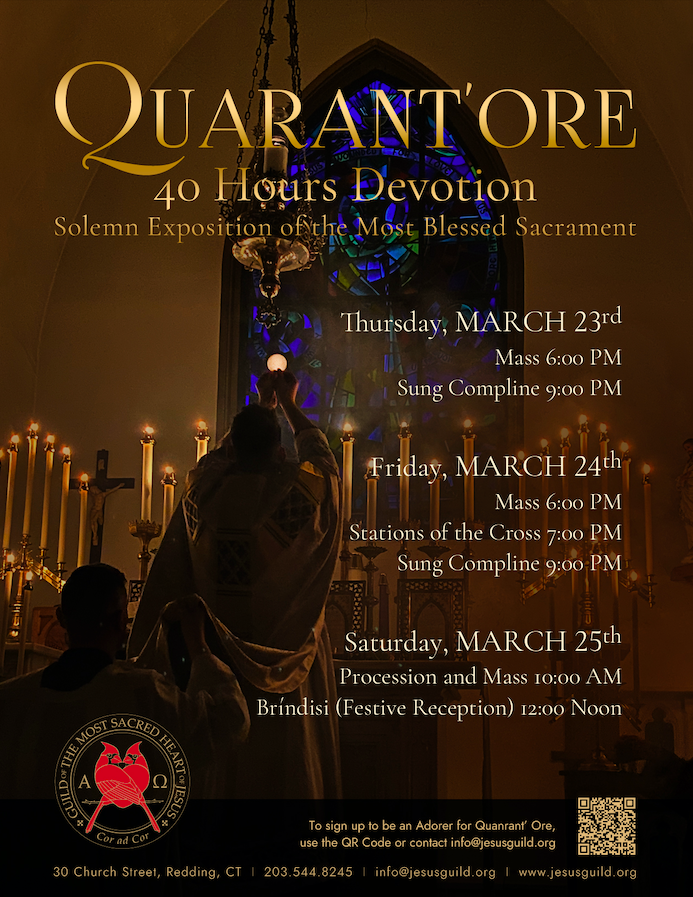
28
Feb
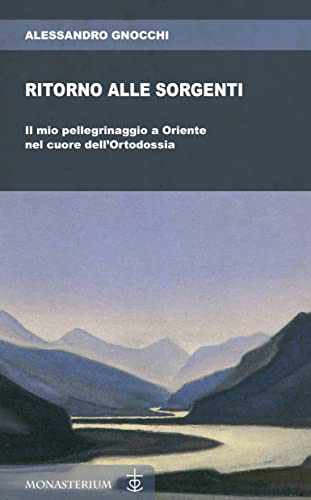
Ritorno alle Sorgenti: Il mio Pellegrinaggio a Oriente nel Cuore dell’Ortodossia (A Return to the Sources: My Pilgrimage to the East in the Heart of Orthodoxy)
By Alessandro Gnocchi
Edizioni Monasterium, Cellio, 2023
The current state of the Church is presenting faithful Catholics with terrible and tragic choices. What can they do to preserve their liturgy, their morality and their Faith and pass them on to their children? One possibility that is increasingly relevant is the Eastern Orthodox Church. To what extent is Orthodoxy a viable alternative to the Roman Catholic Church?
Alessandro Gnocchi is an Italian writer and journalist. For years he worked together with Mario Palmaro tirelesssly defending Catholic tradition in all its aspects. With Palmaro, Gnocchi was one of the earliest and most perceptive critics of Pope Francis. Together, they predicted all too clearly what was about to befall the Catholic Church. Mario Palmaro died in 2014. Since then, I’ve heard little of his colleague in arms. But I now understand that in 2019 Alessandro Gnocchi joined the Russian Orthodox Church (he is now “Aleksandr,” at least when receiving communion). This year, he has published a short book telling of his experiences of Eastern Christianity.
Now in judging this book, we should not be swayed by contemporary political pressures. And the last thing I would want is to rekindle obsolete polemics between Catholicism and Orthodoxy. So, we should not be quick to denounce the author but try to understand what motivated his decision. After all, other Catholic apologists over the years have taken this step, most notably Rod Dreher.
I have some personal insight into the matter since, through much of the 1980s. I was a parishioner at Saint Michael’s Russian Catholic Chapel in New York. Subsequently, I got to know members of the Russian Orthodox community in the United States – especially one good friend who died in 2020.
What does Gnocchi find attractive in Orthodoxy?
We should start with the liturgy. For the Orthodox churches have preserved the ancient liturgies of the Church. They have (generally) resisted the temptation to compromise with the spirit of this age. For example, (though Gnocchi himself seems ambivalent about this point) we should remember that both the Greek Orthodox and Russian Orthodox churches have insisted on retaining liturgical languages that are not easy to understand for speakers of modern Greek or Russian.
Orthodoxy has retained the central role of monasticism and therefore of asceticism and mysticism. These are not just as the preserve of esoteric specialists but are incorporated into the life of the entire church. So, for the Orthodox the center of gravity of their religion is not the patriarchate of Constantinople or of Moscow but the monasteries of Mount Athos. And as Gnocchi points out, those monks who have received the grace for the task undertake the role of counselors or spiritual directors for the laity that have recourse to them. Thus, monasticism is integrated into the world of the Orthodox faithful.
Continuing in this line of thought, the Orthodox Church still treasures the theological and spiritual classics of patristic and medieval times. It celebrates the role of the great saints of the past. In contrast to the West, which generally restricts the sources of its theology to Vatican II and subsequent papal pronouncements, the Orthodox world draws on the Eastern fathers of the church, the Desert Fathers, the mystics of late antiquity and the Middle Ages as well as more modern contributions. These sources are all still living presences in the Orthodox faith.
Gnocchi also speaks of icons and the traditional art of the Eastern Church. In Eastern theology their role is far beyond that of a mere depiction or reminder of a sacred person or event. The icon creates a real presence of that person, of the sacred in the world of today. Therefore, the artist of icons, such as the famous Andrei Rublev, is ideally a holy man, a monk,
Gnocchi has some extravagant praise for the Orthodox monks and elders he has encountered on his “pilgrimage.” But even discounting these exaggerations, what he is really pointing out is that, for all his faults, the Eastern priest, the Eastern monk is still a man of God – he acts as a spiritual leader through the liturgy, through the other sacraments, through his spiritual counsel. The contrast with the Roman Catholic clergy, secularized, bureaucratic, self-regarding and self-promoting, could not be greater. And of course, there is no Pope in Orthodoxy. Gnocchi does not need to write much about patriarchs and bishops. These are not the center of the Orthodox faith.
So far it would seem that Orthodoxy is a most attractive alternative to what passes for Christianity in the Western Church. Yet, this is not the end of the story. As we shall see, I don’t think that Gnocchi makes a very compelling case for the Orthodox Church.
I will start with his style. In extravagant and exalted language, he sings the praises of Orthodoxy and attempts to convey abstruse points of theology. In other passages, particularly in the second half of the book, he turns strident and confrontational on topics like filioque and papal infallibility. Throughout there’s a constant use of Russian terminology. Gnocchi appears to be less a humble sinner or a seeker after truth but that most tiresome of individuals: the religious fanatic.
Now I have heard of this happening to Catholics who become Orthodox. As in Gnocchi’s book, they want to transform themselves into a Russian or Greek and break utterly with the West and their own past. Is this really a consequence of their own Roman Catholic heritage: the obsession with doctrinal terms, the agitated tone, a certain fixation on the clergy? I don’t think it’s just the fault of the converts, however. For the Eastern churches themselves, as I understand it, demand of the new convert complete repudiation of his past and of all his ancestors. I have heard that sometimes a convert has sent such a declaration to the members of his former community or parish – was not this very book written at the instigation of Gnocchi’s elder or “staretz”? (More of this later.)
Here we come to a critical point: the “Eastern” ideology that is forcefully advocated by Gnocchi. This holds that there exists a fundamental difference between Western and Eastern Christianity dating back at least to the 4th century and that the two Churches had evolved into different mutually exclusive worlds many years before the supposedly decisive break of 1054. Indeed, for Gnocchi the decisions of the hierarchies on mutual recognition – or not – play little or no role given this fundamental chasm between West and East. This self-understanding of Eastern Christianity as an unchanging, pure, isolated block descended from Apostolic times is the Orthodox equivalent of Western ultramontanism which tried to find the 19th century papacy in the 4th century and earlier.
This is, of course, historically preposterous. From the 4th century onward the popes of Rome, Western doctors and saints had influenced and interacted with the East just as the doctors, saints and councils of the Eastern Churches did the West. Indeed, Pope Gregory the Great is (probably erroneously ) considered as the author of the Orthodox service of the presanctified gifts. Greek and Eastern popes governed the Church for much of the 7th and 8th centuries. Between 730 and 840 (with one interruption) it was the Eastern Church, not the West, that was dominated by iconoclastic heretics. Neilos, a Greek monk (born in Italy!), recognized as a saint in both East and West. established around 1000 a monastery, Grottaferrata, not too far removed from Rome itself. And, even afterwards, contacts between the two churches were not at all entirely broken off – consider the career of El Greco in the 16th century in Spain, of all places.
Another alienating feature of Gnocchi’s spirituality is his relationship with his elder or staretz. This role of the staretz is personally unfamiliar to me. I had always understood it to involve the voluntary recourse by a layman, let’s say, to the staretz – a monk who makes available to him the spiritual insights gained in the contemplative life. But Gnocchi’s staretz seems to have assumed the controlling role that used to be ascribed to the Jesuits. By the way, it is totally untrue, as is asserted here, that this type of counseling is unknown in in the West. We might mention the anchoresses of medieval England, just as one example.
I hope the reader does not think that the tone of this book, now confrontational, now enthusiastic, at times ranting or overblown, is typical of the faithful of the Orthodox Church. Far from it. The born-and-bred Orthodox have a very relaxed attitude to their faith, as it is as natural to them as their own nationality. After all, the Orthodox Church still places the greatest weight on the role of the nation: Serbian, Greek, or Russian. The nation is the contemporary descendant of the governing function once performed by the Byzantine or Russian emperors. In certain branches of Orthodoxy like the OCA (the Orthodox Church of America) or the Greek Orthodox Archdiocese in America, the relationship with contemporary society becomes perhaps too cozy, resulting in problems like those afflicting the Roman Catholic Church.
And, in contrast to what Gnocchi presents, the attitude of the Orthodox, both laity and clergy, to the Western world is not at all unrelentingly hostile. Consider this passage from Gnocchi’s own book:
In the Orthodox Church the divine liturgy is the most perfect expression of the true faith. When Pope Benedict XVI “liberalized” the celebration of the ancient mass, Patriarch Alexei II commented, “it is a step in the right direction. For if we had touched the divine liturgy, we would never have been able to survive 70 years of state atheism.”
Given its spiritual treasures, I think the case for Orthodoxy can be made. Gnocchi in this book has regrettably not succeeded in doing that. I would think this divisive work would have exactly the opposite effect. That’s a shame. Because amid this darkening world, it is essential that all adherents of Christian Tradition rally in the defense of Christianity and the Truth.
